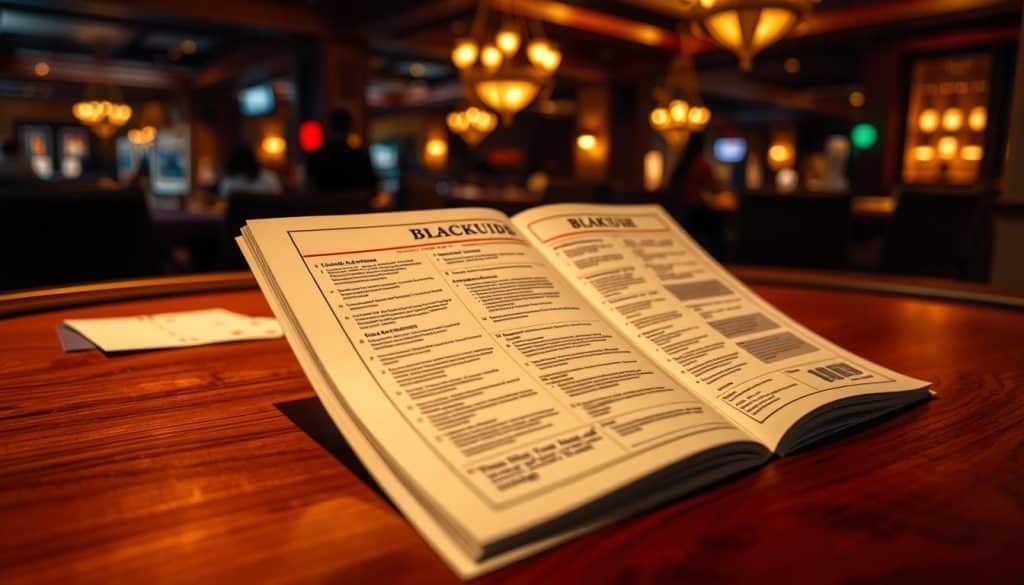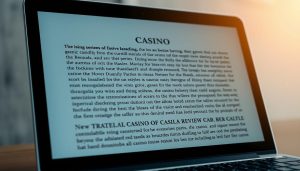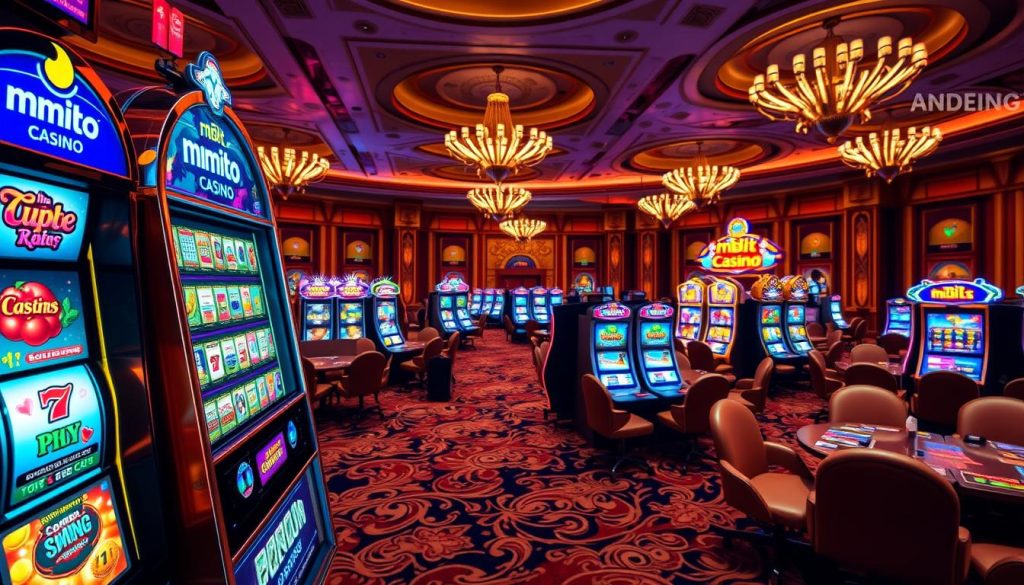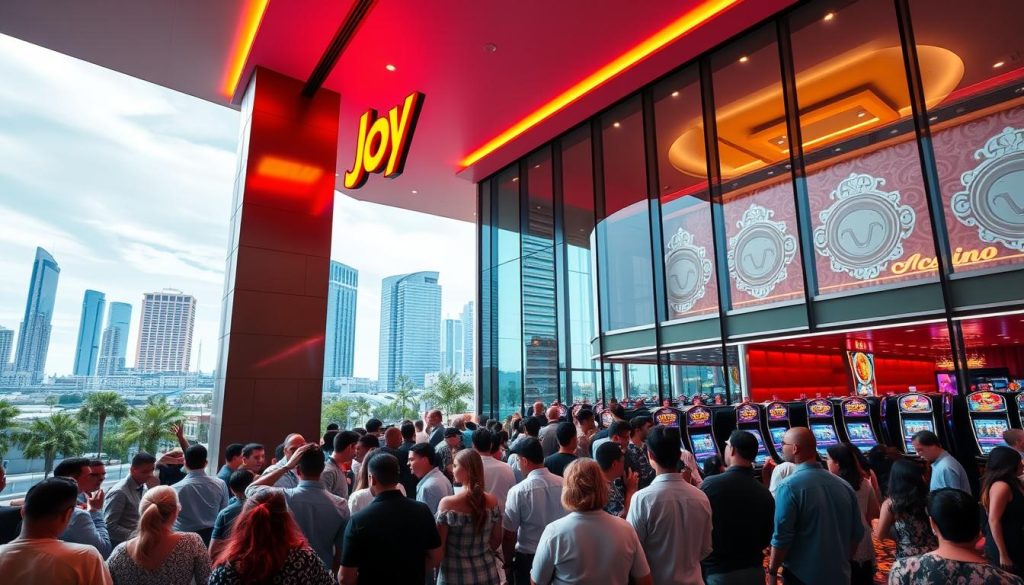Did you know that understanding blackjack basics can reduce the house edge to under 0.5%? This gives you better odds than most casino games. Yet, many players lose money by not grasping even basic blackjack rules.
I’ve studied blackjack for years in casinos and online. The game is simple at its core, but offers depth for those who seek it. You’re not playing against other players, just the dealer.
Your goal is to get closer to 21 than the dealer without going over. It’s that straightforward.
New Zealand’s gambling landscape has changed in 2026. Online regulations have evolved, and new platforms have emerged. Some old strategies still work, while others need updating.
This guide addresses the unique situations Kiwi players face. It covers different legal frameworks, casino options, and payment methods compared to other countries.
Key Takeaways
- The house edge can be reduced to under 0.5% with proper understanding of game fundamentals
- New Zealand’s online gambling landscape has evolved significantly with updated regulations in 2026
- The core objective is simple: beat the dealer by getting closer to 21 without exceeding it
- Kiwi players have access to different platforms and payment methods than other markets
- Learning basic strategy dramatically improves your odds compared to playing on intuition
- Both complete beginners and experienced players can benefit from understanding current NZ-specific conditions
Introduction to Blackjack Rules in New Zealand
Blackjack tables are the heart of New Zealand casinos. The sound of shuffling cards and clicking chips creates an exciting atmosphere. Understanding blackjack rules is key for enjoying this classic game in casinos or online.
New Zealand’s gaming scene has grown a lot. It now includes traditional casinos and online platforms. Blackjack’s main rules stay the same no matter where you play.
Brief History of Blackjack
Blackjack came from European gambling halls centuries ago. It likely evolved from the French game “Vingt-et-Un,” meaning “Twenty-One.” French settlers brought it to North America in the 1700s.
The name “blackjack” has an interesting story. Early American casinos gave special payouts for an Ace of Spades and a black Jack. This rule didn’t last, but the name stuck.
When blackjack reached New Zealand, it found many fans. The basic blackjack rules for beginners stayed the same as the international version. This consistency is one of blackjack’s strengths.
The game’s strategy hasn’t changed despite new technology. The math behind optimal play in 1960s Las Vegas still applies to online blackjack today. This timeless quality makes blackjack special.
Popularity of Blackjack in New Zealand
Kiwi players approach blackjack with a focus on strategy. They prefer calculated play over flashy high-roller styles. This fits well with blackjack’s appeal as a game of skill.
Online platforms have made blackjack more accessible. You don’t need to live near a casino to play anymore. This has made blackjack rules a hot topic among Kiwi gamers.
Blackjack is one of the top three table games in New Zealand. Players like it because it’s simple to learn but rewards skill. Unlike games of pure chance, blackjack lets players use strategy.
The social aspect of blackjack is important too. Players chat about strategy and share experiences at the table. This creates a fun, friendly atmosphere.
Overview of Online vs. Land-Based Casinos
Online and land-based blackjack in New Zealand offer different experiences. Each has its own advantages. Knowing these helps you choose where to play.
Land-based casinos have set hours and limited tables. They also have higher costs, which affect minimum bets. For example, some casinos open from 10 a.m. to 4 a.m. on weekends.
Online platforms changed everything. They offer 24/7 access to blackjack rules and games from anywhere in New Zealand. You can play anytime, even during lunch or at midnight.
| Feature | Land-Based Casinos | Online Platforms | Live Dealer Online |
|---|---|---|---|
| Operating Hours | Limited (typically 10am-4am) | 24/7 availability | 24/7 with scheduled tables |
| Minimum Bets | $10-$25 typically | $1-$5 common range | $5-$15 average |
| Game Pace | Moderate (social atmosphere) | Fast (player controlled) | Moderate (dealer dependent) |
| Variants Available | 3-5 variants per casino | 15+ variants typical | 5-8 common variants |
| Accessibility | Travel required | Instant from home | Instant with social element |
Betting ranges differ greatly between online and land-based casinos. Online platforms often have lower minimum bets. This is great for beginners learning basic blackjack rules.
Time-limited games, like casino cruises, teach important skills. Players learn about managing their time and money. These skills work well for both online and casino play.
Online blackjack lets you use strategy charts without feeling awkward. In a casino, this might draw attention. Online, you can use many resources while playing.
Land-based casinos offer a unique social experience. The energy of a casino floor is hard to replace. Online live dealer games try to copy this, but it’s not quite the same.
Basic Rules of Blackjack
Blackjack’s main goal is simple: beat the dealer without going over 21. The rules are precise and understanding them is crucial. This game is a one-on-one battle between you and the dealer.
Unlike poker, you’re not competing against other players at the table. This key difference shapes how you should approach each hand. Your focus should be solely on the dealer’s cards.
Objective of the Game
In blackjack, your aim is to beat the dealer’s hand without exceeding 21. You win in three ways. First, your hand total beats the dealer’s without going over 21.
Second, the dealer busts while you stay under 21. Third, you get a “blackjack” (an ace plus a 10-value card) and the dealer doesn’t.
Other players’ decisions don’t affect your odds. Don’t worry about their choices. Each player competes independently against the dealer.
Gameplay and Turn Structure
Knowing the flow of a blackjack hand helps you make good decisions. The sequence is always the same. Players bet before any cards are dealt.
The dealer gives two face-up cards to each player. They take two cards for themselves: one face-up (the “upcard”) and one face-down (the “hole card”).
Play moves clockwise from the dealer’s left. Players decide to hit, stand, double down, or split. After all players finish, the dealer reveals their hole card.
The dealer plays according to fixed house rules. They must hit on 16 or less and stand on 17 or more. Some casinos require dealers to hit on “soft 17”.
The dealer’s lack of choice makes blackjack beatable. You see one of their cards and make informed decisions. They must follow a set strategy.
Card Values Explained
Understanding blackjack card values is essential. Numbered cards (2-10) are worth their face value. Face cards (Jacks, Queens, Kings) are all worth 10 points.
Aces are unique. They can count as 1 or 11, depending on what benefits your hand most. This flexibility creates two types of hands: soft and hard.
A soft hand contains an ace counted as 11. You can’t bust by taking another card. For example, Ace-6 is a “soft 17”.
A hard hand has no aces or counts aces as 1. A 10-7 is a “hard 17”. Taking another card risks busting.
| Card Type | Cards Included | Point Value | Strategic Notes |
|---|---|---|---|
| Numbered Cards | 2, 3, 4, 5, 6, 7, 8, 9, 10 | Face value (2-10) | Straightforward counting with no variations |
| Face Cards | Jack, Queen, King | 10 points each | All three valued identically; common in decks |
| Aces | Ace | 1 or 11 points | Creates soft hands; automatically adjusts value |
| Soft Hand Example | Ace + 6 | 7 or 17 | Cannot bust on next card; flexible strategy |
| Hard Hand Example | 10 + 7 | 17 only | Risk of busting on any card above 4 |
All face cards are worth 10 points. This simplifies your mental math considerably. Treat Kings, Queens, and Jacks the same way.
The ace’s dual nature adds strategic depth to blackjack. Knowing if you have a soft or hard hand changes which risks are acceptable.
These basic rules form the foundation of blackjack. Master the objective, turn structure, and card values. You’ll then have the framework to explore strategy and variants.
Popular Variants of Blackjack
Blackjack games can vary significantly from table to table. These variations impact strategy and profit chances. Understanding the differences is crucial for players in New Zealand casinos and online platforms.
Each version requires adjusting your approach. Sometimes the changes are subtle, while other times they’re dramatic. Knowing these variants can greatly improve your gameplay.
The Standard Version Most Players Know
Classic Blackjack is the foundation for all other versions. It’s common in New Zealand’s land-based casinos. The dealer gets two cards initially—one face-up and one face-down.
The peek card system is vital. The dealer checks for blackjack if their up-card is an Ace or ten-value card. This prevents wasting money on splits or doubles.
The core blackjack rules are straightforward:
- Blackjack pays 3:2 (you get $15 for every $10 bet)
- You can double down after splitting pairs
- The dealer stands on all 17s, including soft 17
- Insurance is available when the dealer shows an Ace
These rules create the baseline. Other variants are measured against this standard format. Understanding Classic Blackjack helps you recognize better or worse conditions in other variants.
The Continental Approach
European Blackjack changes the game. The dealer only takes one card initially. They draw their second card after all players complete their hands.
This difference alters your blackjack strategy. You can’t lose extra money from splits or doubles to a dealer blackjack. However, if you split or double, you risk losing those extra bets too.
The strategic adjustment isn’t intuitive at first. Be more conservative with splits and doubles against dealer tens and Aces. The risk extends beyond your initial bet, changing the edge on certain plays.
Most European versions restrict doubling to hands totaling 9, 10, or 11. You can’t double on soft hands or after splitting. These limitations reduce player flexibility but are balanced by other rule variations.
“The dealer’s hole card rule isn’t just procedural—it’s the single biggest factor separating American and European blackjack strategy charts.”
East Coast Favorite with Player-Friendly Rules
Atlantic City Blackjack is popular online for good reason. It offers some of the most favorable blackjack rules. This makes it a smart choice when browsing casino lobbies.
The dealer stands on soft 17, improving your odds. In games where dealers hit soft 17, the house edge increases by about 0.2%. This small difference adds up over many hands.
You can double down on any two cards without restrictions. Even better, late surrender is allowed. This lets you forfeit half your bet after the dealer checks for blackjack.
| Variant | Dealer Hole Card | Double After Split | Surrender Option |
|---|---|---|---|
| Classic Blackjack | Yes (checks immediately) | Allowed | Varies by casino |
| European Blackjack | No (draws after players) | Not allowed | Not available |
| Atlantic City Blackjack | Yes (checks immediately) | Allowed | Late surrender allowed |
The table above shows why variant selection matters. Atlantic City gives you more tools, while European takes some away. Neither is universally “better”—they just require different approaches.
Black Bear Casino offers traditional blackjack alongside unique variants. Free Bet Blackjack covers your split and double bets under certain conditions. Blazing 7s adds a bonus side bet for sevens in your starting hand.
Free Bet Blackjack changes risk calculations. You’ll split and double more often because there’s no extra money at risk. The catch? Dealer pushes on 22 except against player blackjack.
Blackjack strategy isn’t one-size-fits-all. The optimal play in Classic might be wrong in European. What works in Atlantic City could be costly in other variants.
Before playing, check the specific rules posted. Look for blackjack payout ratios, dealer standing rules, and doubling/splitting restrictions. These details determine if you’re playing a favorable game or not.
How to Place Bets in Blackjack
Betting in blackjack is more complex than it seems. The betting structure affects your bankroll management and table experience. Knowing these mechanics is as vital as understanding basic blackjack rules.
Players often overlook checking the minimum bet. This can lead to costly mistakes. For example, finding yourself at a $50 table when you planned to bet $10.
Minimum and Maximum Betting Limits
Blackjack tables clearly display their betting limits. The range varies based on where you’re playing. Online casinos in New Zealand often have lower minimums, starting at $1 to $5 per hand.
Land-based casinos usually set higher minimums, around $10 to $25 per hand. These can increase during peak times. This pricing reflects their operational costs and competitive landscape.
Victory Casino Cruise shows an interesting trend. They accept lower minimum bets than most Florida casinos. This makes blackjack more accessible to a wider range of players.
Maximum limits tell a different story. Online high-limit tables can accept bets up to $1,000 per hand. Land-based VIP rooms may have maximums reaching $10,000 per hand.
Understanding Side Bets
Side bets are optional wagers that run alongside your main bet. They offer higher payouts but worse odds. These bets look tempting but are profit centers for casinos.
Insurance is available when the dealer shows an Ace. It pays 2:1 if the dealer has blackjack. However, this bet increases the house edge and should be avoided.
Perfect Pairs pays when your first two cards form a pair. The payouts vary based on the type of pair. The house edge on Perfect Pairs typically exceeds 5%.
The 21+3 side bet combines your cards with the dealer’s upcard to form poker hands. Like other side bets, it offers excitement but erodes your bankroll faster.
Winning Payoff Ratios
Blackjack payout rules vary between tables. Understanding these is crucial for optimal play. The standard payout structure has been consistent for decades.
A natural blackjack should pay 3:2. This means a $10 bet returns $15 in winnings. Regular winning hands pay 1:1, or even money.
Some casinos offer 6:5 payouts for blackjack. This change adds about 1.4% to the house edge. It’s best to avoid these tables.
| Outcome | Standard Payout | Example ($20 Bet) | Notes |
|---|---|---|---|
| Natural Blackjack (3:2) | 1.5 to 1 | $30 win | Traditional, player-favorable |
| Blackjack (6:5) | 1.2 to 1 | $24 win | Increases house edge ~1.4% |
| Regular Win | 1 to 1 | $20 win | Standard for all non-blackjack wins |
| Insurance Win | 2 to 1 | $40 win | Poor bet mathematically |
When choosing where to play, prioritize the blackjack payout rules. Look for 3:2 payouts for optimal odds. Many online casinos serving New Zealand clearly state their payout structures.
Insurance pays 2:1 when the dealer has blackjack. However, this bet is a losing proposition over time. The dealer has blackjack less than one-third of the time when showing an Ace.
Blackjack betting seems simple, but details matter. Minimums affect accessibility, side bets drain bankrolls, and payout ratios determine your returns. Master these concepts before risking real money.
Basic Strategy for Blackjack
Playing blackjack strategically isn’t about gut feelings or lucky streaks. It’s about math, probability, and making decisions based on computer-simulated hands. Understanding this can save you money and improve your game.
Every hand has a statistically optimal play. This isn’t gambling wisdom passed down through generations. It’s cold, hard data that’s been tested and verified countless times.
Understanding Blackjack Odds
The dealer busts about 28% of the time overall. This number changes depending on their visible upcard. When the dealer shows a 5 or 6, their bust rate jumps to over 40%.
These are “bust cards” – weak positions where the dealer is most vulnerable. When the dealer shows a 9, 10, or Ace, their bust rate drops to around 23%.
These stats determine whether you should hit, stand, double down, or split. The dealer’s upcard creates different probability landscapes. Against a dealer’s 2 through 6, play conservatively. Against a 7 through Ace, be more aggressive.
Optimal Playing Decisions
Basic strategy is the best play for every hand versus the dealer’s upcard. Computer programs have run millions of simulated hands to determine this. It’s pure statistical analysis that removes emotion from the equation.
Following basic strategy consistently reduces the house edge to about 0.5% with favorable rules. This makes blackjack one of the best bets in any New Zealand casino.
Deviating from basic strategy because of hunches costs money over time. The math doesn’t care about patterns you think you’re seeing.
When to Hit, Stand, Double, or Split
Always hit on soft 17 or less, and stand on hard 17 or more. For hard 12 through 16, it depends on the dealer’s upcard.
Double on 10 or 11 against the dealer’s weak upcards. Some players double soft hands like A-6 or A-7 against dealer’s 4, 5, or 6.
Always split Aces and 8s. Never split 5s or 10s. Split 2s, 3s, 6s, 7s, and 9s conditionally.
- Always split Aces and 8s – Two Aces give you two chances at blackjack, and splitting 8s turns a terrible 16 into two playable hands
- Never split 5s or 10s – A pair of 5s totals 10, which is perfect for doubling; 10s already make 20, one of the best hands possible
- Split 2s, 3s, 6s, 7s, and 9s conditionally – These depend on the dealer’s upcard and require memorizing basic strategy charts
Mastering these decisions is essential for New Zealand players serious about the game. It can improve your results by six to eight percent over hundreds of hands.
Blackjack strategy isn’t complicated once you commit to learning it. You don’t need to be a math whiz. Just accept that the optimal play is already calculated and execute it consistently.
Advanced Blackjack Strategies
Advanced blackjack strategies offer informed control over betting decisions. They help you understand why certain situations favor the player or the house. These techniques aren’t magic formulas, but they’re worth learning.
Advanced strategy shifts your thinking from following charts to analyzing game conditions. You’ll learn to adjust your approach based on the current situation.
Card Counting Basics
Card counting isn’t illegal, but it’s not a guaranteed money-maker. You track the ratio of high cards to low cards left in the deck.
High cards (10, Jack, Queen, King, Ace) favor players. They increase blackjacks and make dealer busts more likely. Low cards (2-6) favor the house by helping dealers avoid busting.
The popular Hi-Lo counting system assigns values to cards as they’re dealt:
- Low cards (2-6): +1
- Neutral cards (7-9): 0
- High cards (10-Ace): -1
Keep a running count throughout the shoe. A positive count means more high cards remain, favoring you. Increase your bet when the count is positive.
Convert the running count to a “true count” by dividing by estimated remaining decks. This helps adjust for multiple decks.
Online blackjack often shuffles after every hand, making counting impossible. Live dealer games use 6-8 deck shoes with limited penetration.
Card counting works best in land-based casinos with fewer decks and deep penetration. It may shift the long-term edge 1-2% in your favor.
The Importance of Game Flow
Game flow includes dealer speed, table atmosphere, your mental state, and session structure. These factors significantly impact your play.
Victory Casino Cruise’s five-hour sailing limit creates a natural stopping point. This prevents endless sessions common in land-based casinos.
Decision fatigue affects your ability to execute optimal strategy after several hours. You may start making emotional decisions instead of mathematical ones.
Self-imposed session limits help combat decision fatigue. Set time limits (2-3 hours max) and win/loss limits before playing.
Dealer speed affects game flow too. Faster dealers mean more hands per hour and more exposure to the house edge.
Betting Systems to Consider
Betting systems don’t change the house edge. They do affect variance and your psychological experience of the game.
Common blackjack betting systems include:
| Betting System | Method | Risk Level | Best For |
|---|---|---|---|
| Martingale | Double bet after each loss | Very High | Short sessions with large bankroll |
| Paroli | Double bet after each win | Low to Medium | Capitalizing on winning streaks |
| 1-3-2-6 | Progressive sequence on wins | Medium | Balanced risk/reward approach |
| Flat Betting | Same bet amount always | Lowest | Maximizing playing time |
The Martingale system is risky. It requires doubling bets after losses, which can quickly deplete your bankroll.
The Paroli system increases bets during winning streaks. You set a limit, usually three consecutive wins, before returning to your base bet.
The 1-3-2-6 system follows that sequence in betting units during wins. It tries to maximize streak opportunities while limiting exposure.
Flat betting with basic strategy offers the most predictable results. It gives you the longest playing time without introducing extra volatility.
If using a progression system, set strict loss limits. Never chase losses by increasing bets beyond your predetermined maximum.
Blackjack Tables and Gameplay Mechanics
Blackjack tables come in various layouts, affecting betting limits and game pace. Table configuration impacts your gaming experience significantly. Understanding the game’s structure enhances your play and decision-making abilities.
Large casinos like Victory Casino Cruise showcase diverse table setups. With 27 table games across four decks, they cater to 1,200 passengers. Player numbers fluctuate throughout the day, creating a dynamic gaming environment.
Different Table Configurations
Physical blackjack tables typically seat five to seven players. Each position has a betting circle and a specific name. These names matter more for blackjack table etiquette than strategy.
First base sits at the dealer’s far left, acting first every hand. Third base, on the dealer’s right, makes the last decision. Some believe third base has advantages, but mathematically, position doesn’t change odds.
Online tables simulate this structure, usually with fewer players. The betting circle concept remains the same in digital formats. Software or dealers handle chip placement and game progression.
Table limits vary by location and time. Black Bear Casino’s weekend hours show how operations adapt to demand. Higher-limit tables often have better blackjack rules, like dealer standing on soft 17.
Role of the Dealer
Dealers follow strict house rules, eliminating human decision-making. They act as card-dispensing machines following a set algorithm. Understanding blackjack dealer rules makes their actions predictable.
Dealers must hit on 16 or less and stand on 17 or more. The soft 17 rule (Ace counted as 11 plus 6) varies by casino. Some require hitting (H17), others standing (S17).
S17 slightly favors players as dealers bust more often. H17 increases house edge by about 0.2%, impacting long-term play significantly. Dealers have no discretion in their actions.
Splitting and Doubling Down Explained
Splitting and doubling down are crucial decisions in blackjack. These moves allow increasing bets mid-hand when odds favor you. Skilled players use these options to build their edge.
Splitting divides a pair into two separate hands with an additional bet. Rules on re-splitting and doubling after split vary. Always split Aces and 8s for better odds.
Never split 5s or 10s. Two 5s make 10, ideal for doubling. Two 10s equal 20, already a strong hand. Doubling down doubles your bet for one more card.
Double down on 11 against any dealer upcard (except Ace sometimes). Also consider doubling on 10 against dealer’s 2-9 and 9 against dealer’s 3-6. Soft hands can be doubled against weak dealer upcards.
Clear hand signals are crucial in blackjack table etiquette. Tap for hit, wave for stand, place chips beside your bet to double or split. Visual confirmation is necessary for every decision.
Technology in Blackjack Gaming
Blackjack has evolved from physical casinos to pocket-sized apps over the past decade. This shift has changed how players learn, practice, and engage with the game. New Zealand players now have access to technology that makes blackjack more accessible than ever before.
The digital transformation began slowly but accelerated rapidly. Simple computer programs have grown into complex gaming ecosystems. These systems offer multiple platforms, formats, and experiences for players.
Digital Platforms Bringing Blackjack to Kiwi Players
Online blackjack platforms operate in a legal gray area for New Zealand players. The country doesn’t license online casinos domestically. However, it doesn’t stop citizens from playing on overseas sites.
Major software providers play a crucial role in the online blackjack experience. Evolution Gaming, Playtech, and NetEnt each offer unique approaches. Evolution focuses on live dealer games with multiple camera angles.
Playtech provides a wide range of game variants with different rules. NetEnt prioritizes sleek interfaces and smooth gameplay mechanics. These differences give players options to suit their preferences.
I’ve found that the best platforms share certain characteristics. They display rules clearly and offer multiple game variants. They also provide adjustable game speed to accommodate different player preferences.
Interface quality varies greatly between providers. Some platforms present information clearly, while others create visual clutter. When you’re playing multiple hands per hour, interface design directly impacts your gameplay quality.
Connection stability is crucial for online blackjack. Dropped connections can lead to disputes about bet outcomes. Reputable platforms handle disconnections gracefully, but it’s still frustrating for players.
Mobile Applications Revolutionizing Portable Play
Mobile apps have made blackjack truly portable. Well-optimized apps are available for both iOS and Android devices. The touchscreen interface feels natural, making it easy to tap “hit” or “stand”.
Game performance is a key factor in app quality. Laggy apps can lead to mistimed decisions or accidental actions. Responsive touch controls are essential for serious play.
Many apps include valuable learning tools. Strategy trainers deal practice hands and evaluate your decisions. Hand analyzers let you review past hands to improve your strategy.
Battery consumption varies between apps. Some drain your phone quickly, while others are optimized for longer play sessions. This factor is important for players who enjoy blackjack on the go.
App orientation is another consideration. Some players prefer portrait mode, while others want landscape view. The best apps support both orientations seamlessly.
Live Dealer Technology Bridging Digital and Physical
Live dealer blackjack is an exciting technological development. Real dealers at physical tables stream games in HD to your device. This creates an authentic experience that combines online convenience with land-based play.
The streaming quality directly impacts the experience. HD video with minimal latency allows for clear card visibility and confident decision-making. Poor streaming can disrupt game flow and player enjoyment.
Interactive features vary by provider. Chat functions allow player-dealer interaction, though conversation is limited during hands. Some players enjoy the social element, while others find it distracting.
Multiple camera angles enhance the live dealer experience. Players can view the dealing shoe, table layout, and close-ups of dealt cards. Some providers offer customizable layouts for a personalized viewing experience.
Betting interfaces overlay the video stream. Players click buttons to place chips and make decisions. The interface must be responsive enough for timely bets without being overly sensitive.
| Platform Type | Key Advantages | Best Suited For | Connection Requirements |
|---|---|---|---|
| RNG Software | Fast gameplay, available 24/7, practice modes, lower minimums | Solo players, strategy practice, budget players | 1-2 Mbps minimum |
| Live Dealer | Real card physics, social interaction, authentic experience, transparency | Players seeking casino atmosphere, social players | 5-10 Mbps recommended |
| Mobile Apps | Play anywhere, touchscreen interface, learning tools, optimized for smaller screens | Commuters, travelers, casual players | 3-5 Mbps mobile data |
| Desktop Browser | Larger screen, multiple tables, detailed statistics, full feature access | Serious players, multi-table players, strategy analysts | 3-5 Mbps minimum |
Evolution Gaming offers unique blackjack variants with special features. These include side bets, progressive jackpots, and multiplier zones. While the core rules remain the same, these options add variety for players.
Game history analysis tools let you review recent shoe results. Some players find comfort in statistics about table trends. However, each shuffle creates independent probabilities regardless of past outcomes.
The human element sets live dealer play apart. Dealers develop unique personalities and dealing styles. Some players prefer specific dealers, adding an extra layer of entertainment to the game.
Latency is the biggest technical challenge in live dealer games. Providers use advanced technology to minimize delays. However, your internet connection quality remains the most important factor for a smooth experience.
Understanding Blackjack Payouts
Blackjack payout ratios greatly affect your bankroll growth. They determine how quickly you win or lose money. Casinos profit from these carefully designed payout systems.
Small changes in blackjack payout rules can shift the house edge significantly. This impacts your long-term winnings or losses. Understanding these rules helps you choose the best games.
Standard Payout Ratios
Traditional blackjack has three main payout ratios. A natural blackjack pays 3:2 under standard rules. Regular winning hands pay 1:1, or even money.
Insurance bets pay 2:1 when the dealer shows an Ace. However, these bets are usually not profitable. The odds favor the house in the long run.
“Even money” offers confuse many players. It’s best to decline this offer. The 3:2 payout usually outweighs the risk of a push.
Variations in Payouts Across Different Casino Types
Some casinos offer 6:5 blackjack payouts. This rule change increases the house edge by about 1.4%. Avoid these tables whenever possible.
Online casinos in New Zealand often maintain 3:2 payouts. They have lower overhead costs, allowing better odds for players. Land-based casinos may offer less favorable odds.
Tourist-heavy areas often have 6:5 tables at lower limits. These are more profitable for casinos. Regular players seek out 3:2 tables, even with higher minimum bets.
Influencing Factors for Payouts
Several rule variations impact your effective return. The number of decks used affects the house edge. Single-deck games offer the lowest house edge.
Dealer rules for soft 17 change the odds. Prefer tables where dealers stand on soft 17. Doubling and splitting rules also affect your chances.
Surrender options can reduce the house edge. Early surrender is more favorable than late surrender. Here’s a comparison of different game configurations:
| Game Configuration | Blackjack Payout | Decks | Dealer Rule | House Edge |
|---|---|---|---|---|
| Excellent Rules | 3:2 | Single Deck | Stand on Soft 17 | 0.15% |
| Good Rules | 3:2 | Six Decks | Stand on Soft 17 | 0.40% |
| Average Rules | 3:2 | Eight Decks | Hit on Soft 17 | 0.66% |
| Poor Rules | 6:5 | Six Decks | Hit on Soft 17 | 2.01% |
The house edge affects your expected losses. A higher house edge means you’ll lose money faster. Over time, this can significantly impact your bankroll.
Understanding blackjack rules and payouts helps you make smart decisions. It’s about respecting your money and playing wisely. Knowing these numbers gives you an edge.
Blackjack Statistics and Trends in New Zealand
Blackjack in New Zealand has changed dramatically. Data reveals patterns beyond personal observations. These trends help players make informed decisions about their gameplay.
From 2015 to 2026, blackjack has transformed. Technology, regulations, and player preferences drive these changes. Data comes from official reports and online traffic analysis.
Blackjack Popularity Over Time
Blackjack’s popularity in New Zealand has an interesting history. From 2015 to 2019, the game grew steadily. Players learned that blackjack strategy offered better odds than slots.
COVID-19 changed everything in 2020-2021. Online blackjack activity spiked during lockdowns. Physical casinos closed, pushing players to digital platforms.
The numbers during this time are remarkable. Online casino traffic increased by 300-400% during peak lockdown months. Many first-time players explored virtual blackjack tables from home.
| Year | Online Interest Index | Land-Based Revenue Share | Key Trend Drivers |
|---|---|---|---|
| 2015-2017 | Baseline (100) | 28% of table games | Stable traditional play patterns |
| 2018-2019 | 125-140 | 29% of table games | Mobile platform growth begins |
| 2020-2021 | 380-420 | 15% (venues closed) | COVID lockdowns drive online surge |
| 2022 | 220-245 | 26% of table games | Physical venues reopen, hybrid patterns emerge |
| 2023-2026 | 260-285 | 27% of table games | Stabilization at higher baseline, live dealer popularity |
When physical casinos reopened in 2022, online play didn’t collapse. It stabilized at levels significantly higher than before the pandemic. Players enjoyed the convenience of online platforms.
Blackjack accounts for 25-30% of table game revenue globally. New Zealand follows this trend closely. This suggests that blackjack rules appeal across cultures.
Player Demographics in New Zealand
Blackjack player demographics in New Zealand have changed. Traditional casinos attracted older, male players. Online platforms have made the game more accessible to diverse groups.
Age distribution shows a significant shift. Physical casinos still attract players 45 and older. Online platforms appeal to younger players, with 25-40 year-olds making up 55% of digital players.
Younger players learn blackjack strategy through YouTube and practice apps. They’re comfortable with technology and online interfaces.
Gender breakdown reveals another change:
- Land-based casinos: approximately 75% male, 25% female players at blackjack tables
- Online platforms: roughly 60-65% male, 35-40% female players
- Mobile apps: approaching 45% female participation, especially in lower-stakes games
Online play removes social barriers for some women. They can enjoy the game without navigating crowded casino floors.
Education levels among blackjack players tend to be higher than slots players. Strategy-minded people often prefer blackjack. Blackjack rules reward skill alongside luck.
Income demographics favor middle-to-upper-middle-class players. Blackjack requires larger bankrolls than slots. A comfortable evening of play typically needs NZ$200-500.
Geographic distribution has changed with online platforms. Players across New Zealand now have equal access to blackjack games.
Predictions for Future Blackjack Trends
Several trends will likely reshape blackjack in New Zealand. These predictions come from technology, regulations, and player behavior patterns.
Live dealer evolution is the most certain trend. As 5G networks expand, streaming quality will improve. Live dealer blackjack could capture 40-50% of online play by 2028.
Players want real dealers without leaving home. Technology is finally meeting this demand.
Virtual reality integration generates buzz, but mass adoption seems unlikely. VR blackjack offers immersion but may feel excessive for most players. It might appeal to tech enthusiasts, but probably won’t exceed 5% market share.
Cryptocurrency acceptance is growing slowly. Some platforms already accept Bitcoin and other cryptocurrencies. By 2027, 20-30% of online players may use crypto for deposits.
Crypto offers fast transactions and privacy. Deposits are instant, and withdrawals can clear in hours instead of days.
Artificial intelligence opponents could improve practice platforms. AI systems could adapt to your playing style. This would help players refine their blackjack strategy before risking real money.
Regulatory changes are uncertain. New Zealand currently lacks a legal framework for domestic online casinos. A licensing system could reshape the market dramatically.
Domestic licensing might bring better consumer protections and responsible gambling tools. It could also keep tax revenue in New Zealand. However, it might restrict game offerings or betting limits.
Social gaming features will likely improve. Future platforms might offer better multiplayer elements. This could combine online convenience with the social atmosphere of physical tables.
Blackjack’s core blackjack rules remain unchanged. However, how and where Kiwis play continues to evolve. Understanding these trends helps players adapt their approach.
Frequently Asked Questions About Blackjack
These answers will change how you approach blackjack. They’re honest explanations based on math, experience, and player observations. The answers separate profitable play from expensive mistakes.
The following questions reveal key misunderstandings about blackjack rules and gameplay. They’ll help you make better decisions at the table.
What is the House Edge in Blackjack?
The house edge in blackjack varies based on table rules and your strategy. With perfect play and good rules, it can be as low as 0.15-0.30%.
Typical New Zealand casino games have a 0.5-0.7% house edge with correct basic strategy. This is excellent compared to other casino games.
However, playing 6:5 blackjack or making strategy mistakes can increase the house edge to 2% or higher. Always aim for 3:2 payouts and follow basic strategy.
For context, let me show you how blackjack compares to other popular casino games:
| Casino Game | House Edge Range | Skill Impact | Optimal Strategy Required |
|---|---|---|---|
| Blackjack (3:2, basic strategy) | 0.5-0.7% | High | Yes |
| Blackjack (6:5, poor play) | 2.0-3.5% | High | Ignored |
| European Roulette | 2.7% | None | No |
| American Roulette | 5.26% | None | No |
| Slot Machines | 2-10% | None | No |
Blackjack offers one of the best mathematical advantages in any casino. But you must learn how to play blackjack correctly. Don’t ignore basic strategy charts, even if they’re right in front of you.
Can You Make a Living Playing Blackjack?
Technically yes, but it’s unlikely for most people. Professional blackjack requires a significant bankroll, usually $50,000 minimum. This helps withstand the statistical variance in the game.
You also need advanced techniques like card counting, which only works in specific situations. Online platforms and continuous shuffle machines make counting impossible.
Even with a 1% player edge, you’d only make $100 per hour playing 100 hands at $100 bets. Bad streaks could still cost you thousands despite perfect play.
Casino countermeasures are another barrier. Successful card counters get identified and barred from play. Security teams use facial recognition and betting pattern analysis to spot counters.
For most players, blackjack should be entertainment with minimized losses through proper strategy. The professional path requires capital, skill, time, and stress tolerance.
What Are the Common Myths About Blackjack?
Myth 1: Bad players at third base can make you lose. This is mathematically false. Their decisions help you as often as they hurt you over time.
Myth 2: The goal is to get as close to 21 as possible. No, the goal is to beat the dealer. Sometimes this means standing on 12 against a dealer’s 6.
Myth 3: Card counting is illegal. It’s not illegal in New Zealand. Casinos can refuse service, but you won’t get arrested for counting.
Myth 4: Hot and cold streaks are predictable. Each hand is statistically independent with continuous shuffling. The deck has no memory of previous results.
Myth 5: Insurance is a good bet when the dealer shows an Ace. Insurance is negative for basic strategy players. It only becomes profitable when counting cards.
Myth 6: The dealer is trying to beat you personally. Dealers have no stake in your wins or losses. They follow rules set by casino policy.
Understanding these myths transforms your approach to blackjack strategy. Focus on mathematical decisions, not superstitions or hunches.
Tools and Resources for Blackjack Players
New Zealand players can access quality materials to improve their blackjack skills. These resources help transform basic understanding into confident gameplay. They make learning rules and refining strategies easier.
Essential Reading for Strategy Development
“Beat the Dealer” by Edward Thorp is a 1962 classic. It proved blackjack could be beaten through systematic play. The book established the mathematical foundation for modern strategy.
“Professional Blackjack” by Stanford Wong offers clear strategy advice. It breaks down decisions to match real casino situations. Both books provide comprehensive coverage of strategy systems.
Book Depository ships these titles to New Zealand for free. Digital versions are available on major e-book platforms for quick access.
Online Learning Platforms
Wizard of Odds offers free strategy charts and calculators. Their tools show how different blackjack rules affect your chances of winning.
BlackjackInfo.com has customizable strategy engines. You input specific table rules and get optimized playing decisions. This helps you adapt to different game conditions.
Practice apps like “Blackjack Strategy Practice” let you train risk-free. These trainers track your accuracy and identify areas for improvement.
Player Discussion Spaces
Reddit’s r/blackjack community is a place to share experiences and ask questions. The forum includes views from beginners and experienced card counters.
Using these resources helps build skills step by step. Start with basic strategy materials before moving to more complex systems.










